|
|
|
Sort Order |
|
|
|
Items / Page
|
|
|
|
|
|
|
| Srl | Item |
| 1 |
ID:
151384
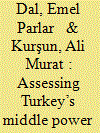

|
|
|
|
|
| Summary/Abstract |
This study attempts to identify possible new roles for intermediary actors in the changing global architecture by focusing on Turkey’s middle power capacity in the nascent middle power network of Mexico, Indonesia, South Korea, Turkey, Australia (MIKTA). It looks at an overarching embedded analytical triad of goals, means, and impact, superimposed over positional, behavioural, and ideational sublayers. It tests the assumption that the more a state holds together its middle power goals, means, and impact in a combined way, the more leverage it can have as a middle power in the changing international political economy. After reviewing the existing literature on middle powers, the first part of this paper outlines this embedded analytical framework. The second and the third parts seek to operationalize this framework, in particular at institutional and state levels in the example of MIKTA and Turkey. The fourth part delves into the opportunities and challenges that Turkey faces in its MIKTA trajectory (in the light of the conclusions drawn from the second and third parts). The study concludes that while Turkey possesses fairly compatible goals and impact with those of MIKTA, it is still far from channelling all of its capabilities to this new network due mainly to the domestic and regional impediments it faces—as well as the lack of a comprehensive roadmap in relation to MIKTA.
|
|
|
|
|
|
|
|
|
|
|
|
|
|
|
|
| 2 |
ID:
151385
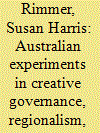

|
|
|
|
|
| Summary/Abstract |
The previous Abbott government had prioritized a general attitude to foreign policy captured by the phrase “Jakarta not Geneva,” which signified a preference for bilateral or minilateral interactions with the region rather than United Nations-based multilateralism. With Julie Bishop MP as Australia’s first female foreign minister, the Coalition also prioritized economic diplomacy, as exemplified by the repeated refrain that Australia is “open for business.”
This approach led to a preference for diplomatic venues and processes that focused on continuing investments in regional architecture, new emphasis on minilateral dialogues such as the Indian Ocean Rim Association (IORA) and Mexico, Indonesia, Korea, Turkey, and Australia (MIKTA), and more effort directed to bilateral and plurilateral processes such as the Trans-Pacific Partnership trade negotiations. This approach has been continued under Prime Minister Turnbull, with a renewed focus on innovation.
Part 1 considers minilateral and regional investments in the Indo-Pacific region, primarily, IORA, the Asia-Pacific Economic Cooperation (APEC), and the Association of South East Asian Nations (ASEAN). I consider MIKTA a unique vehicle for Australian diplomacy. Part 2 considers what issues Australia should be pursuing through these forums, with a focus on the two themes of gender equality (as an example of niche diplomacy) and trade (multilateralism under pressure) as case studies.
|
|
|
|
|
|
|
|
|
|
|
|
|
|
|
|
| 3 |
ID:
151386
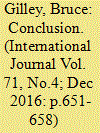

|
|
|
|
|
| Summary/Abstract |
The challenges for middle powers relate directly to their unstable positional status in the international system. Yet this unique position in the international Goldilocks Zone of having not too much power but power enough also gives them unique opportunities. Successful middle powers recognize their middle power status and then formulate a strategic diplomacy suited to this status in which they accept the centrality of great power interests and roles. Too many middle powers fail to do this because they entertain delusions of grandeur, and when those delusions are revealed they fall into isolation or disengagement from global governance.
|
|
|
|
|
|
|
|
|
|
|
|
|
|
|
|
| 4 |
ID:
167223
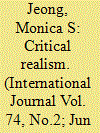

|
|
|
|
|
| Summary/Abstract |
The fundamental problem in middle power scholarship lies in the research design that inadvertently permits bias, tautology, and circularity in the process of realizing the final outcome. Most researchers begin with a presumption that middle powers are countries in the middle range of the world order, capable and willing to play some constructive roles beyond their borders. Thus, they tend to select methods and data compatible with the given presumption, and reach predictable outcomes that determine middle power status by middle power behaviours, or middle power behaviours by middle power status. This is an epistemic fallacy where the ontic category of middle powers is defined by the epistemic knowledge of middle powers. Eventually, any countries with comparable characteristics/behaviours to the given presumption can be classified as “middle powers” conducting middle power behaviours. This article offers critical realism as a much-needed remedy to the stagnant middle power scholarship. It examines a group of countries already categorized as middle powers—Mexico, Indonesia, South Korea, Turkey, and Australia (MIKTA)—under a critical realist framework, and finds that those countries and their activities cannot be generalized by the conventional middle power conception. In fact, the middle power rhetoric itself holds both a positive and negative ideological implication that requires further scrutiny. Yet, what makes the critical realist research design and its findings invaluable is the commitment to ontological realism, epistemological relativism, and judgmental rationalism that addresses the recurring epistemic fallacy. Therefore, the research findings are not merely new insights about “middle power” countries; they are a valid clue that can help uncover the “real” world that causes the so-called “middle power” categorization.
|
|
|
|
|
|
|
|
|
|
|
|
|
|
|
|
| 5 |
ID:
163129
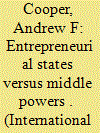

|
|
|
|
|
| Summary/Abstract |
This article highlights both the differences and similarities between the concepts of entrepreneurial states and middle powers. The use of the entrepreneurial state as the central framing device is distinctive in a number of ways, including reducing the emphasis on hierarchy in the global system. Yet for all the divergences, the two frames are indelibly intertwined, above all in privileging agency over structural positioning. In either case there is an element of constant flux and reinvention, which justifies ongoing research. Just when the elevation of the G20 and the appearance of MIKTA appeared to provide some discipline to the image of a middle power, the notion of entrepreneurial states stretches the number of countries to be included. At the same time, however, attributes that reflect some middle power sensibility are embedded within the entrepreneurial state set of practices.
|
|
|
|
|
|
|
|
|
|
|
|
|
|
|
|
| 6 |
ID:
151381


|
|
|
|
|
| Summary/Abstract |
Over the last decade Mexico has chosen and has been forced to practice a sort of “stand alone” foreign policy, in part due to its marginalization in Latin America, in part due to the growing bilateralization of relations in the North American Free Trade Agreement (NAFTA) context. The national narrative of acting as a bridge in economic terms for accessing the NAFTA market proved not very attractive to international partners. As a result, Mexico has become the classical “leader without followers.” Joining the MIKTA initiative, a grouping formed by Mexico, Indonesia, South Corea, Turkey and Australia, is a highly welcomed option for regaining international presence without the Brazilian shadow, so strong in the region, and for defining a specific intermediary role. Mexico clearly embraced a “Southern” identity only in very limited moments of its foreign policy history and always tried to maintain a middle way, as an agreeable voice and a helpful fixer for international conferences and meetings. The old/new formula that seems to feed Mexico’s new international MIKTA presence is that of “multiple memberships” following a rationale of “like-mindedness,” a rationale that allows for promoting its presence in a great variety of institutions and regional integration schemes, but without compromising too much of its national economic development priorities. This article analyzes these half-way/soft doctrinal foundations of Mexican foreign policy with respect to Mexico’s identification with and outreach to the MIKTA group, both in terms of collective action and of bilateral efforts to establish viable relations with its members.
|
|
|
|
|
|
|
|
|
|
|
|
|
|
|
|
| 7 |
ID:
166137


|
|
|
|
|
| Summary/Abstract |
Based on over seventy interviews with diplomats and experts from all five MIKTA member countries, we find that MIKTA is used as a value-for-money minilateral mechanism for the world’s lesser powers grappling with the heightened global uncertainty and deepening interdependency. MIKTA foreign ministries have used the group as an ad hoc capacity-building and network-sharing scheme; and as a low-cost toolkit to diversify their traditional diplomatic channels and increase global visibility in various multilateral forums. However, MIKTA’s flexible, but precarious, institutional realities also suggest that minilateral arrangements that share MIKTA’s operational characteristics are likely to be short-lived and suffer from weak member commitment, resource constraints, forum-shopping risks, and a leadership vacuum.
|
|
|
|
|
|
|
|
|
|
|
|
|
|
|
|
| 8 |
ID:
151379
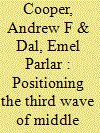

|
|
|
|
|
| Publication |
International Journal Vol: 71 No 4.
|
| Summary/Abstract |
This article argues that middle power diplomacy can be identified as having gone through three distinct waves. The first is connected with the immediate post-1945 global order, with a focus on multilateralism via the United Nations and related bodies. The second moved to ad hoc bursts of activism related to specific issue area niches. The third and current wave, by contrast, is embedded in the informal institutionalization associated with the G20. Just as the BRICS have used the G20 as a catalyst for differentiated activities both around and independent of the G20, the “missing middle” in the G20 (countries increasingly portrayed as middle powers beyond both the BRICS and the G7) have begun to explore the possibility of collective action. MIKTA (Mexico, Indonesia, Turkey, South Korea, and Australia), while possibly a significant advance in global governance, has the potential of hardening the categories of countries identified as middle powers. At the same time, the MIKTA countries face a number of serious constraints in terms of this global reach. Institutional elevation is compromised by practice limitations, most notably the hold of regional imperatives.
Keywords
|
|
|
|
|
|
|
|
|
|
|
|
|
|
|
|
| 9 |
ID:
151383


|
|
|
|
|
| Summary/Abstract |
South Korea has emerged as a new middle power that plays a significant role in a wide range of important global issue areas and supports liberal international order with its leadership diplomacy. Even though regional challenges will continue to demand large foreign policy resources including time, human resources, and budget, the middle power orientation of South Korean foreign policy behaviour and strategy—for example, multilateralism, the rule of law, and promotion of cooperation and compromise—will remain in place even in the conduct of regional foreign policy.
This optimism is based on the fact that South Korea is a middle power not only in global governance but also in the East Asian region. Even on the issue of North Korea’s nuclear weapons, the most important foreign policy challenge of the day, the South has accepted the regionalization of the issue and, over time, its middle power role. It has relied on the middle power strategy of mobilizing international pressure on the North rather than deploying and strengthening its unilateral options such as the use of force or massive economic aid.
In order to fully realize the promise and potential of middle power diplomacy, however, South Korea must make strong efforts to alleviate structural constraints on a middle power strategy. First, Korean leaders should undertake a full-scale campaign to de-nationalize Korean education and, thus, Korean foreign policy orientations. Second, a strong domestic consensus should emerge giving the national interest precedence over group interests when dealing with foreign policy challenges. Finally, political leaders and diplomats must create new opportunities in global governance and deliver tangible national benefits through middle power diplomacy. Middle power diplomacy, like all foreign policy strategies, will not be sustainable without strong domestic support; and domestic support cannot be built on goodwill and commitment to universal values alone.
|
|
|
|
|
|
|
|
|
|
|
|
|
|
|
|
| 10 |
ID:
151380


|
|
|
|
|
| Summary/Abstract |
Middle power conceptualization has been reinvented over the years as the structural weight of this cluster of countries changes. Moreover, the means by which middle powers project normative values and operational diplomatic approaches has morphed with the evolution of the global order. A constant, however, has been the unwillingness of middle powers to embrace some form of institutionalization. The focus has been multilateralism and/or specific functional issue areas or niches. This article argues that the combination of a world of diffuse power and a new type of informalism opens the possibility of collective action. Although MIKTA (Mexico, Indonesia, South Korea, Turkey and Australia) is in an early stage of development, this formation provides a significant test of the meaning and modalities of middle power diplomacy in the twenty-first century.
|
|
|
|
|
|
|
|
|
|
|
|
|
|
|
|
| 11 |
ID:
151382


|
|
|
|
|
| Summary/Abstract |
This article provides a framework to help understand Indonesia’s rise. Although the study of emerging powers has flourished in recent years, much discussion is devoted to explaining large emerging powers, such as Brazil, Russia, India, and China (BRIC). Indonesia’s rise is overlooked because its material capabilities are less than those of the BRIC countries. In order to characterize the emergence of Indonesia, this article establishes a set of parameters to distinguish Indonesia from BRIC and middle powers. The parameters are: (1) attitude toward the international order; (2) performed role; and (3) nexus between regional and global roles. This article argues that Indonesia displays three characteristics that distinguish it from BRIC and middle powers—(1) soft-revisionist; (2) normative bridge building; and (3) accommodative regional leadership. The third and fourth sections of this article test these characteristics through G20 and climate change case studies. This article concludes that the characteristics of Indonesia’s emergence are located in a conundrum between those of BRIC and middle powers. Although it shares some characteristics with BRIC countries, Indonesia is carefully trying to keep a distance from BRIC and to maintain strategic autonomy in relations with other international actors.
|
|
|
|
|
|
|
|
|
|
|
|
|
|
|
|
|
|
|
|
|